History of the Department
Historical Highlights
- The First Chair
To get a university degree in England at the beginning of last century you had to belong to the Church of England. University College was set up by subscription in 1826 and was widely supported by the Nonconformist, Roman Catholic and Jewish communities in the country. One of the many revolutionary aspects of the new university was that of having a Chair of Chemistry right from the outset, the first in England, which was held initially by Edward Turner.
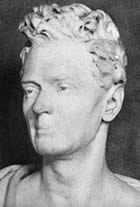
Edward Turner began his career in medicine. He later graduated and lectured at the University of Edinburgh until his appointment as the first Professor of Chemistry at the London University. Turner was Head of Department from 1828 - 1837. He was not a great original thinker but his excellent analytical work enabled him to be the first Briton to accurately ascertain atomic weights and to disprove Prout's hypothesis of atomic weights being integer multiples of hydrogen.
His book "Elements of Chemistry", first published in 1827, gained a European reputation and ran to eight editions. The frontispiece of the 5th Edition, published while he was Professor at UCL in 1834.
Turner was very popular with the undergraduates and on his death the students paid for the bust which appears in the photo at the top of this page. Turner also lectured in Geology.
- The Second Head of Department

Thomas Graham was the second Head of Department, from 1837-1854. Although he is best known for his Law of "Effusion" (diffusion), Graham also made some important early observations on colloids, on polybasic acids, and even on the uptake of dihydrogen by palladium.
Graham lectured at the Andersonian Institute in Glasgow before joining London University.
He was a pioneer, linking the early great advances of Dalton, Davy and Berzelius with modern science. His early researches were into the diffusion of gases, and later, the diffusion of liquids and solids dissolved in liquids, resulting in the discovery of diffusion laws. He also laid the foundation for the branch of science later known as 'Colloid Chemistry'. He was one of the founders and the first President of the Chemical Society. In 1854 he succeeded Herschel as Master of the Mint.
- Ramsay and the nobel gases
In the 1890's Sir William Ramsay was exploring the properties of gases. Lord Rayleigh's observation that the density of atmospheric nitrogen was slightly greater than that prepared by chemical means ultimately led Ramsay to isolate first argon in 1894 and, over the next few years, neon, krypton, and xenon. For this work, Ramsay was awarded the Nobel Prize in Chemistry for 1904.
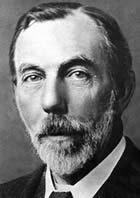
Ramsay studied for an Arts degree at Glasgow University. After working in laboratories both there and on the continent, he became Professor of Chemistry at the new Bristol University for seven years before joining UCL in 1887. Ramsay was Head of Department from 1887-1913. Ramsay's most important contribution to science was the discovery of argon and the other noble gases for which he received the Nobel Prize in 1904.
After his death in 1916, the Ramsay Memorial Fellowships were endowed by public subscription to enable outstanding young scholars to carry out research in chemistry in the UK. Curiously, Ramsay Fellows are expected to give one lecture during their tenure at a University within the city of Glasgow, but not at UCL. Go figure!
Ramsay was the subject of a biography by his friend and colleague, Maurice Travers .
- Christopher Ingold and the 'English heresay'
The 1940's and 50's saw Christopher Ingold and his group lay the foundations of kinetics and mechanism in organic chemistry. It was in this period that nucleophilic substitution (SN1 and SN2) and aromatic nitration were first understood. His monumental work "Structure and Mechanism in Organic Chemistry" is still a cornerstone of organic chemistry.
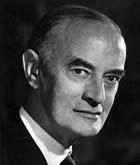
Ingold studied with Jocelyn Field Thorpe at Imperial College London and obtained his D.Sc. in 1921. After six years as Professor of Organic Chemistry at Leeds University he joined UCL in 1930. He became Head of Department from 1937 - 1961. The breadth of his work at Leeds enabled him in 1934 to write the famous review on the electronic theory of organic reactions which became known as the 'English heresy'.
However, the controversy abated and by 1939, Ingold's ideas, terminology and nomenclature for reaction mechanisms (e.g. electrophilic, nucleophilic, inductive, mesomeric, SN1, SN2 etc) were generally accepted and employed everywhere. Much of his work was done in collaboration with E.D. Hughes .
His monumental work "Structure and Mechanism in Organic Chemistry" is a cornerstone of organic chemistry.
He received many honours including the Longstaff Medal in 1957 and a knighthood in 1958. He was largely responsible for the content of the new B.Sc. (Special) Degree which appeared in 1945. He continued lecturing after his retirement.
A biography " Sir Christopher Ingold- A Major Prophet of Organic Chemistry " (compare it with Robert Robinson's autobiography) by Kenneth T. Leffek was published recently. A review of the book appeared in J. Chem. Ed. in 1997. The best way to obtain a copy of this book is from the author: Ken Leffek, 980 Kentwood Terrace, Victoria, BC, Canada, V 8Y 1A6. Telephone and fax: +1 (250) 658 1329.
- Ronald Nyholm and the Inorganic Renaissance
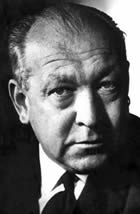
Ron Nyholm was one of the principal players in the renaissance of inorganic chemistry. Nyholm and his group pioneered the use of soft-donor ligands (e.g. phosphines and arsines) with transition metals. He is probably best remembered by undergraduates for the Valence Shell Electron Pair Repulsion theory which he developed with Gillespie.
Nyholm graduated at Sydney University, and after a short stay at UCL, became Professor of Inorganic Chemistry at the University of New South Wales. He returned to UCL in 1955 and became Head of Department from 1963 - 1971. His most important work was the preparation of stable compounds in which a transition metal is in a valence state previously believed to be unstable. He made extensive use of "soft" donors, especially arsines. In rather stereotypically antipodean fashion, he dubbed one of his favourite ligands, ortho-phenylenedimethylarsine, "diars". In 1955 he wrote a key paper entitled "The Renaissance of Inorganic Chemistry" which helped to refocus attention on the subject.
He was much concerned with the teaching of chemistry, and this was reflected in his activities and publications. He was knighted in 1967 and was much mourned after his sudden death in a car accident in 1971.
- Probing the colours of history with Robin Clark
Robin was born in New Zealand and educated at Christ's College and the University of Canterbury, Christchurch, before coming to the UK in 1958 for PhD study in chemistry at UCL.Robin Clark pioneered the applications of Raman spectroscopy to inorganic, mixed valence compounds and to the identification of pigments in historical artefacts. His developments of the theory of resonance Raman spectroscopy have also led to a detailed understanding of excited state geometries
Joining the academic staff at UCL in 1962, he rose to become Dean of Science and then, for 20 years, Sir William Ramsay Professor of Chemistry (recently becoming emeritus). He has lectured widely (in 36 countries) and acted as visiting professor in many universities.
His research in transition metal chemistry, mixed valence chemistry, metal-metal bonding and spectroscopy, which is embodied in over 500 scientific publications, remains very active.
In particular, he has made major contributions to most aspects of Raman and resonance Raman spectroscopy, recently pioneering the application of these and other techniques to the characterisation of pigments in artwork and archaeology - a matter of wide international interest.
- Creating prototype drugs with Robin Ganellin
Robin Ganellin is co-inventor of cimetidine, a drug designed to target the acid-secreting cells in the stomach. Marketed since 1977 under the tradename Tagamet, it has revolutionized the treatment of peptic ulcer disease.
- The smallest water droplet by David Clary
Using rigorous quantum theory, David Clary predicted that a cluster of just six water molecules would, in its lowest energy state, form a cage that has several properties similar to that of liquid water. This prediction has since been confirmed by infrared spectroscopy, and this water cluster has been dubbed "the smallest water droplet".

David Clary joined the department from 1996 - 2003. His research group was involved with theory and computer simulation on the reactions, energy transfer and dynamics of polyatomic molecules. This included problems in the gas phase, clusters, solid surfaces and biomolecules. The work connected with many areas of chemistry and had close links with several experimental groups and has many important applications ranging from atmospheric science to biochemistry.
They were the first group to develop quantum dynamics methods to study energy transfer and chemical reactions involving polyatomic molecules. For a reaction such as:
O + CH4 ->CH3 + OH
They calculated how different vibrational modes of the methane influence the chemical reaction. In addition they predicted the detailed dynamics for the reaction
C + C2H2->C3H + H
which is a mechanism for increasing the length of carbon chains in interstellar space.
The Clary research group also found how to extend quantum methods to the study of chemical reactions occurring on solid surfaces. They predicted the vibrational states of H2 which was formed after reaction between H atoms on graphite. This was thought to be an important mechanism for producing much of the hydrogen molecules in the universe and is also being studied experimentally in the Centre for Cosmic and Physics Chemistry at UCL.
The research group also worked on the diffusion Monte Carlo method for calculating the properties of weakly-bound molecules. Having recently extended this rigorous quantum mechanical method to simulate the hydration of biomolecules and the structures of proteins.
- Spin Ice - David Bramwell
In crystalline ice (H2O), the oxygen atoms form an ordered structure, while the hydrogen atoms are famous for a very special kind of disorder. Steve Bramwell was a co-discoverer of "spin ice", a new kind of magnetic solid found in the ceramic Ho2Ti2O7, in which the magnetic moments or "spins" of the atoms have exactly the same kind of disorder as the hydrogen atoms in ice. The discovery of spin ice provides new insight into a diverse family of scientific problems in which complexity plays a vital role. This group includes computer optimization, neural networks and biological evolution. The work was highlighted in the Financial Times and in UCL News.

Steve Bramwell graduated from Oxford with a degree in Chemistry in 1984, then held positions in Oxford and Grenoble, before joining UCL in 1997. Formerly a Professor of Physical Chemistry, he is now in the Department of Physics and Astronomy at UCL. Alongside his 1997 discovery and naming of of spin ice (with MJ Harris), he is known for his calculation of β = 0.23, a key critical exponent for magnetic films (with PCW Holdsworth, 1993) and a probability distribution named after him (the Bramwell-Holdsworth-Pinton Distribution, 1998). He was awarded the 2010 Holweck Prize of the Britsh Institue of Physics and the French Societe de Physique, to recognise his work on model magnets, and he was the co-recipient of the 2012 European Physical Society CMD Europhysics Prize for the discovery of magnetic monopoles in spin ice. His discovery of "magnetricity" in spin ice was reconginsed by the Times Higher Research project of the Year, 2010 and he appeared on The Times's 2010 list of the 100 most important UK scientists.
The Chemical History of UCL
The below table of content was written by Professor Alwyn G. Davies
- The Beginning 1826

The story begins in 1826, and the hero of the time is Jeremy Bentham. He was a philosopher and educationalist and reformer, and he was of the opinion that university education in England at that time was in a sorry state.
There were only two universities in England, Oxford and Cambridge, and to graduate at either you had to be a member of the Church of England. If you were Jewish or Catholic or Nonconformist or whatever, you could not get a degree in England, and you had to go to mainland Europe, or to Scotland, which was educationally more advanced. Also Oxford and Cambridge were strong in mathematics, theology, and classics, but they had no departments in natural sciences and none in modern languages.
Bentham and his followers therefore set out to found a new university with two guiding principles: it would ask no questions about religion on entry, and it would introduce modern studies. This would be the first new University in England for 400 years, and was to become University College.
- The College Song
In A.D. eighteen twenty-six, a hundred years ago,
Our London was a wilderness, as probably you know,
And where the Gardener's mansion stands the weeds were wont to grow
A hundred years ago.Weeds were growing where the Coll. is,
Weeds were growing where the Coll. is,
Weeds were growing where the Coll. is,
A hundred years ago.The Jeremiah Bentham (call him Jeremy for short)
Deliberated long and then decided that he ought
to found a little College where good learning might be taught,
A hundred years ago.Thought he'd found a home of learning,
A hundred years ago.Then in the weedy wilderness a noble structure grew,
The Architect, Bill Wilkins, and the artist Flaxman too
Combined to make the College what it is to me and you,
A hundred years ago.Jeremiah built the College,
A Hundred years ago.Then, lying on his deathbed, Jeremiah made a will:
Said he "Preserve my body with the utmost of your skill,
And place me in the library that all may see me still,
A hundred years from now."Though his life is long departed,
His body's with us still.They set him in a cupboard in the Science Libraree:
They dressed him in the clothes he wore that future folk might see
Just what the beau ideal of an Englishman should be,
A hundred years from now.Just to show us what we should be,
A hundred years from now.[We hope to have a recording of this song, together with a special updated and entirely scurrilous version written specially for this lecture, available for download at a later date.]

The Autoicon
I know that you would all like to sing it, but there really is not time. Let's look first at the last two verses.
Bentham was an eccentric: "Then lying on his deathbed, Jeremiah made a will, said he, preserve my body with the utmost of your skill, and put me in the library, that folks may see me still, a hundred years from now...."
"so they sat him in a cupboard in the Science Libraree, they dressed him the clothes he wore that future folks might see, just what the beau ideal of an Englishman should be, a hundred years from now".
And of course, they did just that. Here is he as we now know him, sitting the South Cloisters, providing a model for future generations of students. At the centenary and sesquicentenary of the college, he was brought out to the College Committee meeting. He sat at one end of the table, the Provost at the other, and the minutes record 'Jeremiah Bentham, present but not voting'.
- The Building
The painting shows the architect, William Wilkins, showing the plans of the building, to Jeremy Bentham, (the man in the hat) and the other founders. Behind them is the portico, still surrounded by scaffolding.
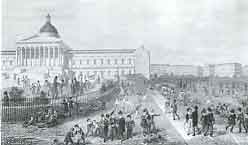
Two years later, Wilkins designed the National gallery in Trafalgar Square, and I think we got much the better dome.
The part of the college initially built is shown in the engraving below. This comprised the portico and dome, and the cloister wings on either side.
There were plans for the North and South wings, but the funds ran out and these were not added till much later. The College was opened in 1828. There was no religious bar to entry, it had no faculty of theology, and became known as the Godless College. And it set up the first departments in England of subjects such as modern languages, geology, zoology, and of course chemistry.
- The First Location
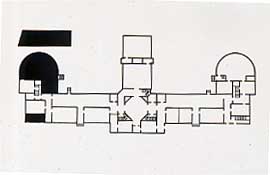
The room to the west (bottom left) is called the Professor's Room, the small rectangular room is the Professor's Laboratory, and next to it is the semicircular lecture theatre. There was no accommodation for undergraduate practical work: that did not come until the separate rectangular building was set up to the east of the theatre. That theatre was in use until 1913, and is shown below.
The room to the west (bottom left) is called the Professor's Room, the small rectangular room is the Professor's Laboratory, and next to it is the semicircular lecture theatre. There was no accommodation for undergraduate practical work: that did not come until the separate rectangular building was set up to the east of the theatre. That theatre was in use until 1913, and is shown below.

- Edward Turner 1828

So we have a College established, and within it a Chemistry Department, and now we need a Professor.
We invited Michael Faraday who was at the Royal Institution, but he wrote a long letter in reply saying that he thought he had to stay there two or three more years to repay the debt that he owed them, and the man we appointed was Edward Turner from Edinburgh; our first four Heads of Department, up to 1913, were from Scotland where there were already thriving chemistry departments.
Turner was only 29 when he was appointed. He thought that there was too much hypothesis and too little established fact in chemistry, and he set about establishing analytical methods by which atomic weights could be determined. The slide shows Turner's figures from 1833 and the IUPAC values which are presently accepted, and the agreement is remarkable. There was at the time a hypothesis (Prout's hypothesis) that all atomic weights were multiples of that of hydrogen, and if the atomic weight of hydrogen was one, then all the others should be integral numbers. Turner was sure of his figures for, for example, chlorine and he proclaimed that "Dr. Prout's hypothesis cannot be upheld".
Turner wrote two books, "The Laws of Chemical Combinations", and, in 1827, the first organic text book, "Elements of Chemistry" and which went to 8 editions with Liebig as editor and gained a European reputation. The frontispiece of the 5th edition, published while he was Professor at UCL in 1834.
- Examinations

With the college established, and teaching started, the inevitable first examinations were held. The most obvious thing about the picture is that all the students are men. Women were not admitted until the 1860's, and then only under conditions which ensured complete segregation. They came and left through a separate gate, they attended separate lectures from the men, and, to cap it all, the men's lectures started on the hour, and the women's on the half hour, to ensure that they never met. It was not until 1871 that men and women were allowed to attend the same lectures, first in the Slade school, and then in the late 1870's in the other departments.
- Thomas Graham 1836

Turner was followed as Head of Department in 1836 by Thomas Graham. He was the founding president of the Chemical Society (now the RSC), and its headquarters in Cambridge (Thomas Graham House) are named after him.
He was a mainly a physical chemist, and he spent a lifetime's work on the study of molecular motion: initially in gases (Graham's law of effusion), then between gases and liquids, and then between gases and solids.
Some of this later work was carried out when he had left University College and become Master of the Royal Mint. In his work on coinage metals, he became interested in the fact that some metals, such as iron and nickel and particularly palladium would absorb large volume of hydrogen. Palladium will absorb 650 times its volume of hydrogen; this of course was the beginning of the story of cold fusion.
Graham regarded this solid solution as an alloy of the volatile metal hydrogen, its volatility being restrained by the in-volatile metal palladium, and he had a medal struck of a solution of hydrogen in palladium, and presented it to Sir John Herschel who was his predecessor as Master of the Mint.
- The Birkbeck Laboratory
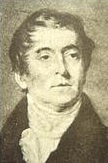
With grant a from George Birkbeck (shown above, after whom another University of London college is named), Graham was responsible for the construction of the first laboratory designed for undergraduate practical work, the Birkbeck Laboratory, which is shown below.

Again, of course, in 1845, all the students are men. You will see in the image of the Birkbeck lab above that some of them are wearing top hats; presumably these are the demonstrators. Attempts to get demonstrators to wear hats of any description have, in recent years, failed.
Graham was followed in 1855 by Alexander Williamson from Edinburgh, another Scot. Together with Wurtz and Hoffmann, he integrated the isolated discoveries of organic chemistry into a coherent whole. His work is illustrated in the next page.
- A. Williamson 1855
Williamson, by his ether synthesis, showed that mixed ethers, with two different alkyl groups, could be prepared.
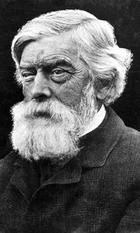
Bonding in organic compounds at that time was thought to be of either the water type, as in alcohols, ROH, or of the radical type, as in ethers which would be given the formula RO.
But Williamson, by his ether synthesis, showed that mixed ethers, with two different alkyl groups, could be prepared. Ethers thus has to have the water-type formula ROR', and oxygen had the equivalent weight of 8 but the atomic weight of 16. By this type of argument he established and rationalised the structures of many of the families of simple organic compounds. Thus, in 1850 he predicted the existence of acetic anhydride, which was prepared in 1851.
We still have some examples of his early apparatus, and his copper pelicans, in which he prepared ether, are shown below. When you realise the scale on which these reactions were carried out, and the fact that the pelican was heated over a charcoal brazier, it is remarkable that we do not seem to have records of catastrophic accidents taking place.

Later on Williamson, again with people such as Liebig, was responsible for the introduction of much of the glassware which we are familiar with today, except that it was usually fitted together with corks rather than ground glass joints. Standard joints, blown in a mold, as we know them today did not come into use until the middle of the last (20th) century.
Towards the end of his period as Head of Department, Williamson became very much involved in College and University politics, and his research suffered. This was the period when the other London colleges - Kings, Birkbeck, Queen Mary, what is now Imperial College, and so on were combined into a federal university, and presumably Williamson felt the need to fight the University College corner.
- Chemical and Physical Society
In 1876, the Chemical and Physical Society was established, with Oliver Lodge as the first President. In that first year there were 41 paying members and 7 honorary members; it held 17 meetings, with an average attendance of 15. It is of course still going strong, and can claim to be the oldest student scientific society in England.
We would welcome any suggestions or volunteers to write a History of ChemPhysSoc, if you are interested please email Alwyn Davies
- New Laboratory 1881

In 1881, the North and South wings of the College, which were on the original plans, were at last built, and Chemistry moved into accommodation in the North Wing, which now houses the Slade School.
The teaching laboratory is shown as an engraving and as a photograph below. The engraving makes it look more like a cathedral than a laboratory. The students called the alcoves in which they worked, "horse-boxes".
In 1881, the North and South wings of the college, which were on the original plans, were at last built, and Chemistry moved into accommodation in the North Wing, which now houses the Slade School.The teaching laboratory is shown as an engraving and as a photograph below. The engraving makes it look more like a cathedral than a laboratory. The students called the alcoves in which they worked, "horse-boxes".
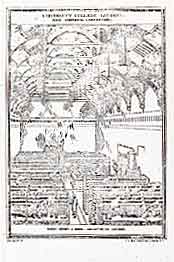
Etching of Teaching Laboratory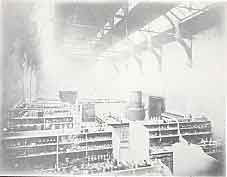
Photograph of the Teaching Laboratory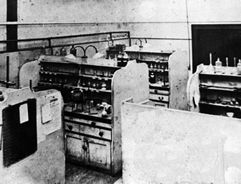
Another view of the horseboxes- Sir William Ramsay 1887

In 1887, Williamson was succeeded as Head of Department by Ramsay, another Scotsman, from Glasgow.
Ramsay was an outstanding experimentalist. He rolled his own cigarettes, claiming that machine-made ones were unworthy of an experimentalist. He kept a platinum spatula on his watch chain for poking his students' precipitates, and he modestly ascribed his success in isolating the rare gases to his large flat thumb which could close the end of eudiometer tubes full of mercury. In 6 years he added a whole new group to the Periodic Table, and it makes a fascinating story. There is a plaque set into the wall of what is now a studio in the Slade building saying 'Here in this room in 1894, Sir William Ramsay KCBE, FRS, discovered...'
- The Discovery of Argon
On April 19th 1894 Ramsay heard Lord Rayleigh lecture to the Royal Society, when he pointed out that nitrogen isolated from the air had a density slightly higher than that of nitrogen prepared from chemical sources. A litre of pure nitrogen gas generated from a chemical reaction weighed 1.2505 g. On the other hand, a litre of nitrogen gas generated from air by removing oxygen, carbon dioxide, and water vapour weighed 1.2572 g (at the same temperature and pressure). Rayleigh thought that this might be due to the presence of a light impurity in the former (Rayleigh's paper is available online).
But Ramsay thought that it might be due to the presence of a heavy impurity in the 'atmospheric' nitrogen. He was an enthusiast for the Newland/Mendeleev Periodic Table and we have Mendeleev's signature in one of our books of visitors. He thought that there might be an unrecognised new element hiding in the air, and that there might be room for this in a new Group at the end of the Periodic Table. When examinations had finished, Ramsay set about attempting to isolate this 'impurity'.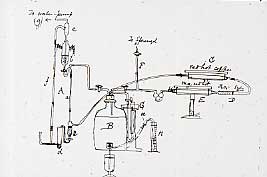
A picture of the Argon Apparatus taken from his notebooks. You may want to compare this with that in his book 'The Gases of the Atmosphere' on the next page.

The Period Table, before Ramsay's discovery
- Ramsay's Apparatus for Isolating Argon

Ramsay repeatedly passed nitrogen from the air over red hot magnesium, which reacted to form magnesium nitride, and as the volume decreased, the density rose. 22 Litres of the gas with a density of 14 were reduced to 1.5 l with a density of 16.1, and then finally to a residual 290 cm 3 with a density of 16.1 and then to 290 cm 3 with a density of 19.95, and which would no longer react with magnesium. Measurement of the specific heat showed it to be monatomic, and therefore the atomic weight was 39.9, and it fitted into the Periodic Table between chlorine and potassium as the first member of a new Group. With the advice of a colleague from the Classics Department, he called this gas argon, after the name argon given in the Greek Old Testament to describe 'the workers who stand idle in the market place'.

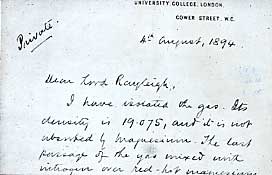
On August 4th he wrote to Rayleigh: 'I have isolated the gas; Its density is 19.4, and it is not absorbed by magnesium...'. These experiments were later described by Lord Rayleigh in an informal but fascinating evening lecture.
Ramsay's paper on the discovery is also available online.
(We are grateful to Prof Carmen Giunta for putting the above papers online).
- The Discovery of Neon and Other Gases
In 1895, Henry Meirs, at the British Museum, told Ramsay that, on heating, a mineral cléveite gave off a gas that Meirs though might be nitrogen. Ramsay thought that it might be a compound of argon. He sent out his technician to a minerals dealer for a specimen of cléveite and, in two days, he showed that it was a new inert gas, helium, the spectrum of which Sir William Crookes had observed from the light of the sun in 1868. With an atomic weight of 4, it fits between hydrogen and lithium, in the same group as argon.
They were now faced with an almost insuperable problem: they have found the first and the third member of the Group, and now need to find the intermediate member, and Ramsay says: "Here is a supposed gas, endowed no doubt with inert properties, and the whole world to find it in". After 2 years, he decided that it might be hiding in the atmosphere. At the Royal Institution in Piccadilly, Dewar had liquefied air in 1872. Ramsay and his student, Maurice Travers , cooled bulbs of argon in liquid air, and separated off the uncondensed portion. Under an electrical discharge it gave blaze of crimson light, and they called it Neon, the newcomer.

Ramsay's Apparatus of the Isolation of Neon
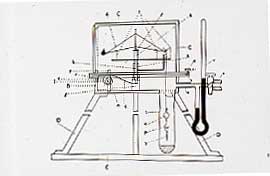
A drawing of the Whitlaw-Gray balanceWe have many of Ramsay's original gas tubes and a direct vision spectrometer which he used to observe the discharge which they gave, and these tubes will still show their discharge with a Tesla coil. We hope to include photos of these at some later stage.In 1898, they cooled the crude neon with liquid hydrogen and isolated the forth and fifth members of the series, Krypton (the hidden one), and Xenon (the stranger) which was present in air to the extent of 1 in 108 .
Rutherford had shown that thorium gave what he called an "emanation". In 1900, Ramsay and Soddy showed that this was the sixth rare gas, Radon. Whytlaw Gray determined the density on a volume of gas of 3.2 x10 -8 cm3 !! We still have fragments of the silica frame of the balance.
- Ramsay's Nobel Prize
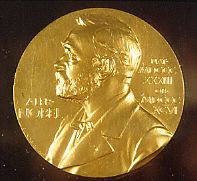
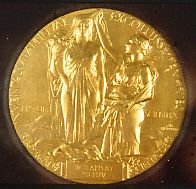
In 1904, Ramsay was awarded the Nobel Prize in Chemistry 'for his discovery of the inert gaseous elements in air, and his determination of their place in the Periodic system'.
As a result Ramsay became a considerable celebrity in London and was cartooned both by Spy for Vanity Fair and by Henry Tonks, Head of UCL's Slade School of Art.

A cartoon by Sir Henry Tonks shows Sir William Ramsay reading that he has won the 1904 Nobel Prize for Chemistry.
We also have his medals and decorations, including the Nobel Medal, which we kept in the safe as we thought it was solid gold - until we read that he had his gold medals melted down and the proceeds given to charity, and what we had were the duplicates that he had made.

Ramsay was also an accomplished pianist, composer, and poet. Here is a copy of letter from Rudyard Kipling, where Kipling thanks him for a march tune that Ramsay has composed to which Kipling hopes to write the words. Look at the date: it is 13 August, 1914, 10 days after Germany crossed the border into Belgium, and 9 days after Britain had declared war on Germany
- The Death Knell of an Atom
In those pre-television days, people made their own entertainment, and we have many songs and poems in the archives about the affairs of chemistry and of the department of those days. Most of these were performed at the Lab Dinner. I will offer you only two, both by Ramsay.
The first is dated 1902, when radioactivity, discovered by Becquerel and the Curies between 1885 and 1900 was the hot topic of the day.
The Death Knell of the Atom
Old time is a-flying; the atoms are dying;
Come, list to their parting oration:-
"We'll soon disappear to a heavenly sphere
"On account of our disintegration,"Our action's spontaneous in atoms uranious
"Or radious, actinious , or thorious;
"While for others the gleam of a heaven-sent beam
"Must encourage our efforts laborious."For many a day we've been slipping away
"While the savants still dozed in their slumbers;
"Till at last came a man with gold-leaf and tin can,
"And detected our infinite numbers."So the atoms, in turn, we now clearly discern,
Fly to bits with the utmost facility;
They wend on their way, and in splitting, display
An absolute lack of stability.'Tis clear they should halt on the grave of old Dalton
On their way to celestial spheres;
And a few thousand million - let's say a quadrillion -
Should bedew it with reverent tears.There's nothing facetious in the way that Lucretius
Imagined the chaos to quiver;
And electrons to blunder, together, asunder,
In building up atoms for ever.- J Norman Collie's Appointment
The second poem was composed and sung by Ramsay at the Lab Dinner to note the appointment to a Chair of Norman Collie, who ultimately was to become his successor. As you will see, Collie was a bachelor, and came to the Department from Cheltenham Ladies College.
Song, written and sung by William Ramsay at the Lab Dinner
When first I came to London town as Williamson's successor
And donned his figurative gown as chemical Professor,
With Plimpton who, with Rideal too, I felt uncommon Jolly,
And in my mind I had in view our friend J. Norman Collie .In Cheltenham his mission lay to train the girls in science,
And demonstrate to them each day some chemical appliance.
But weariness on him depressed, and deepest melancholy,
Right glad he was to come to us, our friend J. Norman Collie .And now the pharmaceutical has made him his professor,
He's found a chair and settled there, it undisturbed possessor.
And now he's only got to wed some Sally, Jane or Polly.
Come fill a bumper, drink a health: our friend J. Norman Collie .- Norman Collie 1913

Ramsay retired in 1913 to be succeeded by Norman Collie. The Department now moved to a new building in Gower Place which was used a military hospital in the 1914-1918 war. Its location is shown on the plan below.
Collie was a man of many accomplishments, and is known as much for being a mountaineer as for being a chemist. To quote C R Bailey's speech at the 1966 Lab Dinner: 'He climbed most of the peaks in the Rockies and named half of them. He was beautiful water colourist, a first class fisherman, a jolly good shot, an international expert on china, and had the best poor man's collection in England'.
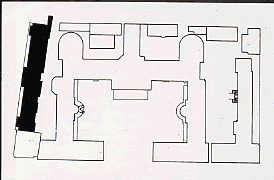
The location of the Ramsay and Forster Laboratories in Gower Place.
The new laboratories in Gower Place.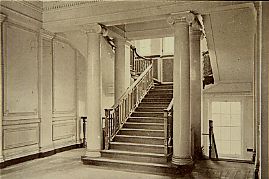
The Main Entrance to the Ramsay and Forster Labs. The building now renames Kathleen Lonsdale, houses Geology and Computer Sciences Departments.His scientific achievements included two notable firsts. He was the first in the UK to use X-rays for medical purposes, and the picture shows two aspects of a woman's thumb with a needle stuck in it.
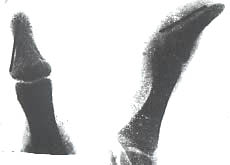
The second, more dubious, achievement was the first use of neon discharge tubes for display purposes.
- Frederick Donnan 1928

Collie was succeeded in 1928 by Frederick Donnan. After Graham's day, physical chemistry had been largely lost to mainland Europe, and Donnan was instrumental in restoring Britain's place in physical chemistry. He is best known for the Donnan equilibrium which refers to the diffusion of ions across a membrane in the presence of a non-diffusible ion.
He had a heavy political clout. He worked closely with the chemical industry, and as Foreign Secretary of the Royal Society he worked to bring over many Jewish refugees from Germany before the 1939-1945 war. Many of these spent a short period at University College before moving on to more permanent posts; two of these were Freundlich, of surface chemistry fame, and Edward Teller, later to be one of the fathers of the atomic bomb.
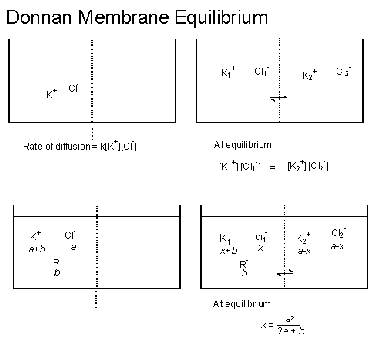
- Sir Christopher Ingold 1937

In 1937, Christopher Kelk Ingold followed Donnan as Head of Department. Ingold's work was based on the principle that, as all bonding is electronic in origin (a covalent bond resulting from the sharing of a pair of electrons), all chemical reactions, which involve the breaking and formation of bonds, must therefore be electronic reactions. Any theory of chemical reactions must therefore be, basically, an electronic theory: we need to understand the principles which govern the rest position of electrons in molecules in their grounds state, and then the way in which they move when reactions occur.
The nomenclature that he introduced, which now is a part of the everyday day fabric of chemistry, is shown in the next slide. The two most familiar systems which he elucidated are those of aliphatic nucleophilic substitution and of electrophilic aromatic substitution.
Ingold's work
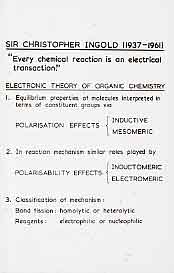
Ingold did much of his work in collaboration with E.D. Hughes, a Welshman whose father really did know Lloyd George. Whereas Ingold operated at a level of cerebration which students could only aspire to, Ted Hughes was very down to earth. At Aberystwyth he objected to the verdict of a weighing machine on the prom and had to be dissuaded by a local constable from tipping it into the sea. And at Bangor, when Don Llewellyn played soccer for Bangor City, Ted dribbled his waste paper basket round his office to show him how it should be done. He always kept quiet about he fact that he ran a string of racing greyhounds, and was regularly given a racing calendar at the Department's Christmas party.
During the war, the Department was evacuated to Aberystwyth in Wales, which imposed a large Department on a small one. There is a story (from Jim Millen) illustrating Ingold's concentration of chemistry to the exclusion of other distractions. He did his duty of overnight fire watching at the chemistry department, and his wife Hilda acted as the departmental secretary. He was walking home after an overnight stint, thinking of aromatic nitration, as she was walking into the department. She said 'Good morning, Professor Ingold'. He replied politely 'Good morning madan', raising his head, not appreciating who he had spoken to.
- The Ingold/Hughes Cartoons
In 1944, the Department returned to London, and in 1947 (?) Hughes rejoined Ingold from Bangor. There was a talented cartoonist, John Mackie, in the Department at the time, and the event is recorded in one of Mackie's drawings. Others illustrated mesomerism and steric hindrance, and one, drawn on the occasion of the award of the Chemical Society's Longstaff medal. shows the leading members of the Department at that time.
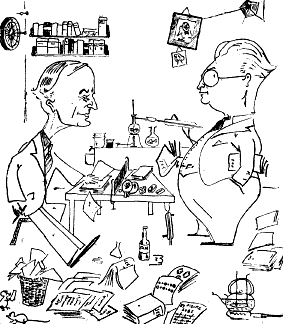
'Together again'
'Mesomerism'
'The latest triumph'
'Steric Hindrance'- Edward Hughes 1961

Ingold retired in 1961 and was followed by Hughes. Hughes, however, died the following year, and Ron Nyholm became Head of the Department in 1963.
At the end of the 1939-1945 war we had a invasion of Australians and New Zealanders, led by Alan Maccoll, who had come here on the recommendation of Tommy Iredale who had been in the Department before the war. This had an autocatalytic effect, and at one time, the annual Departmental cricket match was run on the basis of Australia versus The Rest. The team list reads as hall of fame of Antipodean Chemistry: Alan Maccoll, David Craig, Peter de la Mare, Brian England, Ian Ross, Dick Bramley, Ron Nyholm, Brian Figgis ...though some were better at tennis.
- The Ingold Laboratories
The present laboratory in Gordon Street was intended as the first phase of a more extensive rebuilding, but the academic and financial climate changed. Part of the Department moved across in 1969, and for some years we operated on two sites as shown on the diagram below which shows the location of the 'New Chemistry' relative to the older building.
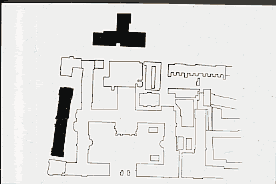
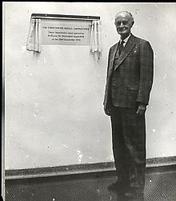
The new building was opened by Sir Christopher Ingold himself.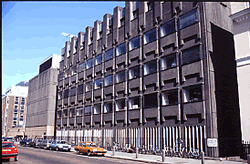
After some internal conversions and the addition of the new top floor, the department was consolidated into the present building in the late 1970's.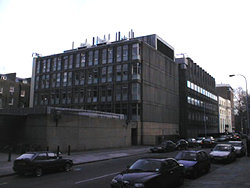
It was sometimes hard to believe that this building came second in the London Borough of Camden's "Best Building of 1970" list. One has to wonder about the other contenders. The internal conversions have continued steadily over the years.- The Finale
Modern text books always finish each chapter with a list of things you should have learned. My list is shown below:
1828 Edward Turner 1836 Thomas Graham 1855 Alexander Williamson 1887 Sir William Ramsay 1913 Norman Collie 1928 Frederick Donnan 1937 Sir Christopher Ingold 1961 Edward Hughes 1963 Sir Ronald Nyholm 1971 Alwyn Davies 1974 Max McGlashan 1989 Robin Clark 1999 David Williams There is one interesting point about the list that may strike you. The first four on the list are all Scotsmen, but we saw a good reason for that. The last three however are all New Zealanders, which is less easy to understand. The only reason that I can offer is a remark, perhaps not completely serious, given by the Provost (Sir Derek Roberts) at the meeting at which David Williams was appointed. When all the business was settled, the Dean of Science asked, facetiously, whether there was any limit to the number of New Zealanders the College could appoint to the Chemistry Department. 'No', said the Provost, 'if we keep on looking we might find a good one'. Provosts usually do not have time for such pleasantries.
That list reads rather like a list of the kings of England; it is a convenient way in which to document history, but does not do justice to the many other people of the Department that we have not had time to recall. You will find many of them on our Periodic Table of the Lecturers . We would be delighted and grateful for any reminiscences and stories you might like to add to either this history or to the PTL. Send comments by email to The WebMaster.
Past Presidents of ChemPhysSoc
- Past ChemPhysSoc Presidents
1876-78 O J Lodge
1878-80 C A Bell
1880-82 H F Morley
1882-84 R T Plimpton
1884-86 C E Cassal
1886-88 S Rideal
1888-89 E E Graves
1889-90 A H Fison
1890-91 J N Collie
1891-92 C F Baker
1892-93 J C Chorley
1893-94 E C C Baly
1894-95 N Eumorfopoulos
1895-96 J Shields
1896-97 M W Travers
1897-98 A M Kellas
1898-99 A W Porter
1899-1900 F G Donnan
1900-01 H P Stevens
1901-02 E C C Baly
1902-03 S Smiles
1903-04 J K H INGLIS
1904-05 N T M Wilsmore
1905-06 F T Trouton
1906-07 A W Stewart
1907-08 R Whytlaw-Gray
1908-09 A W Porter
1909-10 A C G Egerton
1910-11 A O Rankine
1911-12 W C McC Lewis
1912-13 D O Wood
1913-14 F G Donnan
1914-15 J I O Masson
1915-16 A O Rankine
1916-17 H Terrey
1917-18 A W Porter
1918-19 J N Collie
1919-20 N Eumorphopoulos
1920-21 J I O Masson
1921-22 Sir William Bragg
1922-23 J C Drummond
1923-24 O L Brady
1924-25 A W Porter
1925-26 W E Garner
1926-27 Sir Oliver Lodge
1927-28 S Barratt
1928-29 C R Bailey
1929-30 R Robinson
1930-31 L F Gilbert
1931-32 C K Ingold
1932-33 W E Gibbs
1933-34 C K Ingold
1934-35 F G Donnan
1935-36 C F Goodeve
1936-37 H Terrey
1937-38 O J Walker
1938-39 S Sugden
1939-40 H G Poole
1940-41 C R Bury
1941-42 E H Ingold
1942-43 D Gwynne Davies
1943-44 J N E Day
1944-45 F C Chalklin
1945-46 H J Evans
1946-47 C R Bailey
1947-48 C Dodd
1948-49 E D Hughes
1949-50 K Lonsdale
1950-51 A MacColl
1951-52 H S W Massey
1952-53 R J Gillespie
1953-54 D J Millen
1954-55 P B D De La Mare
1955-56 A D Allen
1956-57 C A Vernon
1957-58 A G Davies
1958-59 C A Bunton
1959-60 J H Ridd
1960-61 Sir Christopher Ingold
1961-62 D P Craig
1962-63 R S Nyholm
1963-64 A MacColl
1964-65 M L Tobe
1965-66 D J Millen
1966-67 J H Callomon
1967-68 M H B Stiddard
1968-69 P J Pauling
1969-70 R A Ross
1970-71 S H Walmsley
1971-72 R J H Clark
1972-73 H J Milledge
1973-74 S Doonan
1974-75 T Tthirunamachandran
1975-76 R D Carrott (aka P J Garratt )
1976-77 Lady (E H) Ingold
1977-78 M L McGlashan
1978-79 M D Johnson
1979-80 J E Parkin
1980-81 A MacColl
1981-82 F L Pearce
1982-83 A J Deeming
1983-84 J E Anderson
1984-85 M B Ewing
1985-86 D J Millen
1986-87 A J Bloodworth
1987-88 M R Truter
1988-89 M L McGlashan
1989-90 C R Ganellin
1990-91 A G Davies
1991-92 G Hogarth
1992-93 J H Ridd
1993-94 M H Abraham
1994-95 D E Williams
1995-96 P Day
1996-97 D C Clary
1997-98 W B Motherwell
1998-99 D X Williams (aka A Sella)
1999-2000 S L Price
2000-01 S T Bramwell
2001-02 Piers Gaffney
2002-03 D.W.Lewis
2003-2004 P.F. McMillan
2004-2005 A.S. Wills
2005-2006 C.R.A. Catlow
2006-2007 M.J. Porter
2007-2008 J.K. Cockcroft
2008-2009 J.R.G.Evans
2009-2010
2010-2011
2011-2012
2012-2013 Simon Banks
2013-2014 Robert G Palgrave
2014-2015 Matthew Blunt
2015-2016 Tracey Clarke
2016-2017 Caroline Knapp
2017-2018 Gemma Louise Davies
2018-2019 Stephen E Potts
 Close
Close




